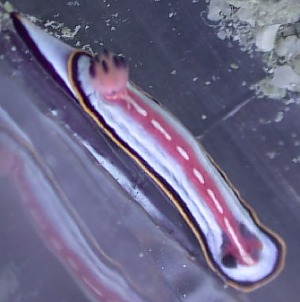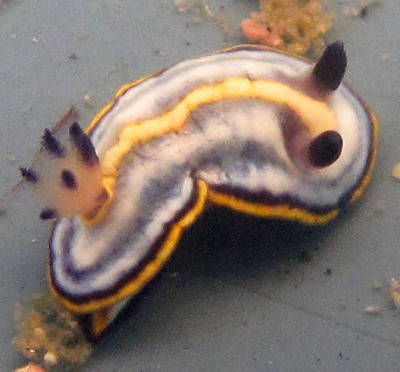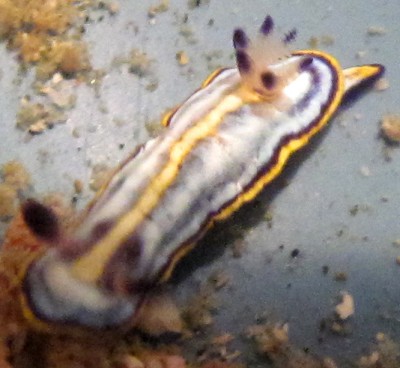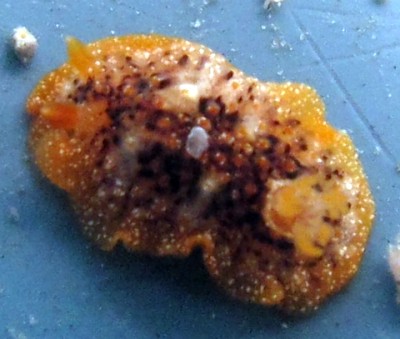
Mexichromis antonii
(Bertsch, 1976)
Order: NUDIBRANCHIA
Suborder: DORIDINA
Superfamily: EUDORIDOIDEA
Family: Chromodorididae
DISTRIBUTION
Pacific Coast of central America [Sonora, Mexico to Panama].
PHOTO
Careyeros, north of Punta Mita, Nayarit. [Pacific coast of Mexico]. Depth: 13 feet, Length: 12 mm. Photo: Alicia Hermosillo
The background colour of the mantle would appear to be a translucent with pinkish - purplish tinge, but this is obscured by a series of concentric colour bands starting at the mantle edge and extending in to the level of the rhinophore and gill pockets. Right at the edge there is a bright orange band, followed by one of purplish black. Inside that is a double band of milky bluish white, the two bands being separated by a thin shadowy purplish band which is most obvious laong each side of the mantle. The whitish bands are almost lumpy in appearance, and around the anterior end of the mantle they almost merge into one band. In the pinkish median region there is a broken white band running from in front of the rhinophores back to the gill pocket. The rhinophore club is deep purple, while the stalk is translucent pink. The gills are translucent clear with deep purple tips.
The body and foot is an opaque milky blue with a deep purplish black border to the foot. It grows to at least 12 mm in length.
Although not immediately obvious, this species has many colour similarities to Mexichromis antonii, which has the same 5-banded mantle margin, with the inner 'milky' coloured almost merging anteriorly and the colourless gills with purple tips.
-
Bertsch,H (1976) A new species of Chromodoris (Opisthobranchia: Nudibranchia) from tropical west America. The Veliger, 19(2): 156-158.
-
Bertsch, H. (1977) The Chromodoridinae nudibranchs from the Pacific coast of America. Part I. Investigative methods and supra-specific taxomony. The Veliger, 20(2): 107-118.
-
Bertsch, H. (1978) The Chromodoridinae nudibranchs from the Pacific coast of America. Part III. The Genera Chromolaichma and Mexichromis. The Veliger, 21(1): 70-86.
-
Camacho-Garcia, Y., Gosliner, T. M., and Valdés, A. (2005) Field Guide to the Sea Slugs of tropical Eastern Pacific. San Francisco, California Academy of Sciences. 1-129.
-
Marcus, Er. & Marcus, Ev (1967) American opisthobranch mollusks. Part 1, Tropical American opisthobranchs. Studies Tropical Oceanography, Miami 6(1-2): 1-137. (Figs 1-150, Pl.1, figs 1-9)
-
Rudman, W.B. (1984) The Chromodorididae (Opisthobranchia: Mollusca) of the Indo-West Pacific: a review of the genera. Zoological Journal of the Linnean Society, 81: 115-273.
Rudman, W.B., 2006 (March 13) Mexichromis antonii (Bertsch, 1976). [In] Sea Slug Forum. Australian Museum, Sydney. Available from http://www.seaslugforum.net/find/mexianto
Related messages
Mexichromis antonii from Ecuador
May 31, 2010
From: Annika Mackensen


Dear Sir,
I am working with bivalves and currently investigating the epifauna of Spondylus species along the mainland coast of Ecuador. I found two nudibranchs, which I am unable to identify (however, I gues the first is some sort of Chromodoris?). I hope this is an easy task for a specialist, besides the fact that the pictures are not so good. I would highly appreciate any help with the family names or anything else.
Locality: Esmeraldas, 16-18 metres, Ecuador, Eastern Pacific, 8 April 2009, sandy bottom. Length: less than 2 cm. Photographer: Soledad Luna.
Thank you so much in advance,
Annika Mackensen
amackensen@institutonazca.org
Mackensen, A.K., 2010 (May 31) Mexichromis antonii from Ecuador. [Message in] Sea Slug Forum. Australian Museum, Sydney. Available from http://www.seaslugforum.net/find/23139
Dear Annika,
I don't think we know very much about the opisthobranch fauna of Ecuador so your photos are of interest. The animal in your upper photo is indeed a chromodorid. I am sure it is Mexichromis antonii, although as you will see from the few photos on the Forum the central part of the mantle differs a bit in colour. This species is known from the eastern Pacific but I suspect Ecuador is much further south than it has been found before.
Concerning your second species. I prefer different species to be sent in different messages as it means they can be associated with a Fact Sheet. However I have no idea what this is. It may be a species of Dendrodoris but that is a guess. Hopefully someone with local knowledge may recognise it.
Best wishes,
Bill Rudman
Mexichromis antonii from Mexico
March 26, 2002
From: Alicia Hermosillo


Dear Bill,
Here is a photo of Mexichromis antonii, to accompany my message about Hypselodoris agassizii and the other similarly coloured species
It was collected at Careyeros, north of Punta Mita, Nayarit. [Pacific coast of Mexico]. Depth: 13 feet, Length: 12 mm. (It is missing a rhinophore: there was a strong surge).
Alicia Hermosillo
alicia_titan@infosel.net.mx
Hermosillo, A., 2002 (Mar 26) Mexichromis antonii from Mexico. [Message in] Sea Slug Forum. Australian Museum, Sydney. Available from http://www.seaslugforum.net/find/6544Dear Ali,
It is nice to see photos of this, the type species of Mexichromis, and its relative, M. tura.
Best wishes,
Bill Rudman
